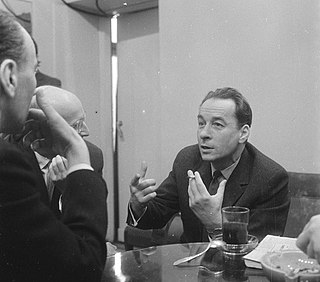Polish composer Karol Szymanowski worked on his Symphony No. 1 in F minor Op. 15 between 1906 and 1907.

Karol Maciej Szymanowski was a Polish composer and pianist, the most celebrated Polish composer of the early 20th century. He is considered a member of the late 19th-/early 20th-century modernist movement Young Poland and widely viewed as one of the greatest Polish composers.
In musical composition, the opus number is the "work number" that is assigned to a composition, or to a set of compositions, to indicate the chronological order of the composer's production. Opus numbers are used to distinguish among compositions with similar titles; the word is abbreviated as "Op." for a single work, or "Opp." when referring to more than one work.
Szymanowski struggled with the composition. He wrote in a letter from 1906 that it was going to "turn out to be some sort of contrapuntal-harmonic-orchestral monster" [1] and going so far as to say "I don't like it". [2] He only completed the first movement and the finale and these two movements had a single performance at the Warsaw Philharmonia, conducted by Grzegorz Fitelberg on 26 March 1909 before Szymanowski withdrew the score.

Grzegorz Fitelberg was a Polish conductor, violinist and composer. He was a member of the Młoda Polska group, together with artists such as Karol Szymanowski, Ludomir Różycki and Mieczysław Karłowicz.
The symphony is scored for 3 flutes, 3 oboes, 4 clarinets, 3 bassoons, 6 horns, 3 trumpets, 3 trombones, tuba, percussion (4 players), 2 harps and strings.

The Western concert flute is a transverse (side-blown) woodwind instrument made of metal or wood. It is the most common variant of the flute. A musician who plays the flute is called a flautist, flutist, flute player, or (rarely) fluter.

Oboes belong to the classification of double reed woodwind instruments. Oboes are usually made of wood, but there are also oboes made of synthetic materials. The most common oboe plays in the treble or soprano range. A soprano oboe measures roughly 65 cm long, with metal keys, a conical bore and a flared bell. Sound is produced by blowing into the reed at a sufficient air pressure, causing it to vibrate with the air column. The distinctive tone is versatile and has been described as "bright". When the word oboe is used alone, it is generally taken to mean the treble instrument rather than other instruments of the family, such as the bass oboe, the cor anglais, or oboe d'amore

The clarinet is a family of woodwind instruments. It has a single-reed mouthpiece, a straight, cylindrical tube with an almost cylindrical bore, and a flared bell. A person who plays a clarinet is called a clarinetist.
The two movements are:
- Allegro moderato
- Allegretto con moto grazioso
The playing time is approximately 20 minutes.











